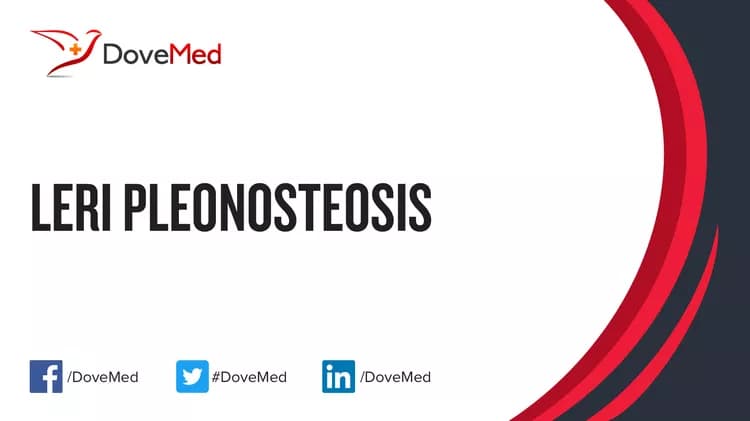What are the other Names for this Condition? (Also known as/Synonyms)
- Leri Type Pleonosteosis
- Leri's Pleonosteosis
- Pleonosteosis, Leri type
What is Leri Pleonosteosis? (Definition/Background Information)
- Leri Pleonosteosis is characterized by broadening and deformity of the thumbs and great toes in a valgus position (a 'spade-shaped' appearance), flexion contracture of the interphalangeal joints, generalized limitation of joint mobility, short stature, and often mongoloid facies
- Additional malformations include genu recurvatum, enlargement of the posterior neural arches of the cervical vertebrae, and thickening of the palmar and forearm fasciae
- A few multigenerational families have been reported so far. The disease is inherited in an autosomal dominant manner
(Source: Leri Pleonosteosis; Orphanet, National Institute of Health and Medical Research (INSERM), Paris.)
Who gets Leri Pleonosteosis? (Age and Sex Distribution)
- Leri Pleonosteosis is a rare congenital disorder. The presentation of symptoms may occur at birth
- Both males and females may be affected
- Worldwide, individuals of all racial and ethnic groups may be affected
What are the Risk Factors for Leri Pleonosteosis? (Predisposing Factors)
- A positive family history may be an important risk factor, since Leri Pleonosteosis is an inherited condition
It is important to note that having a risk factor does not mean that one will get the condition. A risk factor increases one’s chances of getting a condition compared to an individual without the risk factors. Some risk factors are more important than others.
Also, not having a risk factor does not mean that an individual will not get the condition. It is always important to discuss the effect of risk factors with your healthcare provider.
What are the Causes of Leri Pleonosteosis? (Etiology)
- A few multigenerational families have been reported so far
- Leri Pleonosteosis is inherited in an autosomal dominant manner
(Source: Leri Pleonosteosis; Orphanet, National Institute of Health and Medical Research (INSERM), Paris.)
Autosomal dominant: Autosomal dominant conditions are traits or disorders that are present when only one copy of the mutation is inherited on a non-sex chromosome. In these types of conditions, the individual has one normal copy and one mutant copy of the gene. The abnormal gene dominates, masking the effects of the correctly function gene. If an individual has an autosomal dominant condition, the chance of passing the abnormal gene on to their offspring is 50%. Children, who do not inherit the abnormal gene, will not develop the condition or pass it on to their offspring.
What are the Signs and Symptoms of Leri Pleonosteosis?
The signs and symptoms of Leri Pleonosteosis may include:
- Abnormality of the carpal bones
- Abnormality of the vertebral column
- Brachydactyly
- Broad metacarpals
- Broad thumb
- Enlarged interphalangeal joints
- Genu recurvatum
- Hallux valgus
- Joint stiffness
- Laryngeal stenosis
- Pes cavus
- Short metacarpal
- Short metatarsal
- Short palm
- Short stepped shuffling gait
- Short thumb
- Upslanted palpebral fissure
Occasionally present symptoms in 5-29% of the cases:
- Blepharophimosis
- Cubitus valgus
- Microcornea
(Source: Leri Pleonosteosis; Orphanet, National Institute of Health and Medical Research (INSERM), Paris.)
How is Leri Pleonosteosis Diagnosed?
Leri Pleonosteosis is diagnosed on the basis of the following information:
- Complete physical examination
- Thorough medical history evaluation
- Assessment of signs and symptoms
- Laboratory tests
- Imaging studies
- Biopsy studies, if necessary
Many clinical conditions may have similar signs and symptoms. Your healthcare provider may perform additional tests to rule out other clinical conditions to arrive at a definitive diagnosis.
What are the possible Complications of Leri Pleonosteosis?
The complications of Leri Pleonosteosis may include:
- Difficulty in walking
- Physical deformities
Complications may occur with or without treatment, and in some cases, due to treatment also.
How is Leri Pleonosteosis Treated?
There is no cure for Leri Pleonosteosis, since it is a genetic condition. The treatment is usually given to manage the signs and symptoms and any complications that develops.
How can Leri Pleonosteosis be Prevented?
Currently, Leri Pleonosteosis may not be preventable, since it is a genetic disorder.
- Genetic testing of the expecting parents (and related family members) and prenatal diagnosis (molecular testing of the fetus during pregnancy) may help in understanding the risks better during pregnancy
- If there is a family history of the condition, then genetic counseling will help assess risks, before planning for a child
- Active research is currently being performed to explore the possibilities for treatment and prevention of inherited and acquired genetic disorders
Regular medical screening at periodic intervals with tests and physical examinations are recommended.
What is the Prognosis of Leri Pleonosteosis? (Outcomes/Resolutions)
- The prognosis of Leri Pleonosteosis is dependent upon the severity of the signs and symptoms and associated complications, if any
- Individuals with mild conditions have better prognosis than those with severe symptoms and complications
- Typically, the prognosis may be assessed on a case-by-case basis
Additional and Relevant Useful Information for Leri Pleonosteosis:
The following DoveMed website link is a useful resource for additional information:
Related Articles
Test Your Knowledge
Asked by users
Related Centers
Related Specialties
Related Physicians
Related Procedures
Related Resources
Join DoveHubs
and connect with fellow professionals


0 Comments
Please log in to post a comment.